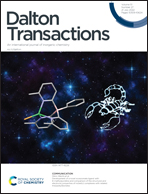Organopnictogen(iii) bis(arylthiolates) containing NCN-aryl pincer ligands: from synthesis and characterization to reactivity†‡
Abstract
Salt elimination reactions between organopnictogen(III) dichlorides, RPnCl2 [R1 = 2,6-(Me2NCH2)2C6H3, Pn = Sb (1), Bi (2); R2 = 2,6-{MeN(CH2CH2)2NCH2}2C6H3, Pn = Sb (3), Bi (4); R3 = 2,6-{O(CH2CH2)2NCH2}2C6H3, Pn = Sb (5), Bi (6)] and 2 equivalents of KSC6H3Me2-2,6 afforded the isolation of a series of new NCN-chelated monoorganopnictogen(III) bis(arylthiolates), RPn(SC6H3Me2-2,6)2 [R1, Pn = Sb (7), Bi (8); R2, Pn = Sb (9), Bi (10); R3, Pn = Sb (11), Bi (12)]. Compounds 7 and 8 are unstable upon exposure to a dry O2 atmosphere and their aerobic decomposition yields the monoorganopnictogen(III) oxides, cyclo-[2,6-(Me2NCH2)2C6H3Pn(μ-O)]2 [Pn = Sb (13), Bi (14)] with concomitant formation of the corresponding disulfide, ArS–SAr (Ar = C6H3Me2-2,6). The oxidative addition of elemental sulfur or selenium to 7 undergoes a similar reaction path and gives stable heterocyclic species cyclo-[2,6-(Me2NCH2)2C6H3Sb(μ-E)]2 [E = S (15), Se (16)]. The reaction of 12 with I2 (1 : 1 molar ratio) gives the diiodide [2,6-{O(CH2CH2)2NCH2}2C6H3]BiI2 (17), along with the S–S oxidative coupling by-product, ArS–SAr. The use of an excess of iodine affords the crystallization of a 2 : 1 iodine adduct of 17 (17·0.5I2), built through halogen bonding. All new compounds were characterized by multinuclear NMR spectroscopy and ESI-MS as well as single crystal X-ray diffraction (except compounds 9 and 10).



 Please wait while we load your content...
Please wait while we load your content...